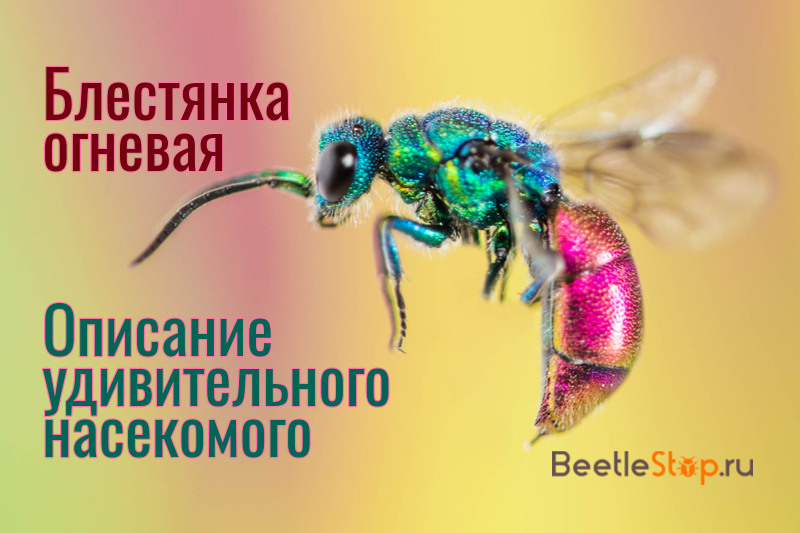Fire woman - wasp without a sting
In the world fauna, 3,000 species of glacial wasps of the family Chrysididae (chrysidides) are known. Stem-bellied insects are distinguished by attractive appearance. Their slender flexible bodies are painted in green, blue, red with a metallic sheen. Fireworm is one of the most common species living in Europe and Asia. Representatives of the chrysidide family are kleptoparasites, the larval stage of which lives at the expense of other wasps and bees in the nests of the hosts.

Morphological description of the species
Fire spangle or flame red (Chrysis ignita) belongs to the family and genus of glitter wasps. Stem-bellied insects with a size of 5-13 mm have a slender body of double color. The head and back are blue with a green tint, the abdomen is fiery red, less often purple. Hues vary depending on the angle of view. The external integument is textured, the body is completely covered with a dot and notches and protrusions. The hairline of the wasp is rare, the hairs are short, bright, upright.
On the sides of the head are large convex eyes of the facet type, occupying most of it. Antennae 11-segmented, attached below base of eyes. The mouth organs are gnawing. Mandibles simple, well developed, with two apical teeth.
Information. The fireworm is a completely harmless insect; it has no poison. The sting is reduced and adapted for a telescopic ovipositor in females and a fertilization organ in males.
The glitter has two pairs of transparent webbed wings. The front pair is longer than the rear, folding at rest on the back. The structure of the abdomen is characterized by a reduced number of visible segments. The anatomy of the organ is associated with the defensive mechanism of the insect. In case of danger, the fire brilliant is curled up, turning the abdomen to the head. Antennae and extremities are bent under the body, which the strong jaws of the hostess wasps can easily bite off. On the third tergite 4 sharp teeth.
Information. Cinderella is called the cuckoo wasp. They lay their eggs in the nests of other species of wasps.
Distribution area
Insects live throughout the Western Palaearctic from Europe to Central Asia, China and Japan. In Latvia, Norway, Sweden, Denmark, the species is quite rare. Typical Hymenoptera insect for southern and central Europe. The flameworm is found in the UK, in the Canary Islands, in Algeria.
Features of reproduction and development of offspring
Fleaces are active throughout the summer, they appear in May and fly until September. Chrysidides are single wasps, they live separately, do not build nests. Only the female is engaged in offspring. Wasps live in gardens, parks, forest edges. Choose places with sandy soil, flowering plants, an abundance of dead trees. Adults feed on pollen and nectar.
Adults often gather on the walls of old buildings and fallen trees. Insects choose sunny places. Females are looking for nests of red osmium, bees from the megahilida family. Single bees settle in small colonies in cracks of tree bark or between stones. Their nests become home to fiery larvae.
In addition to osmium, the owner of chrysidides is the potter wasp, which nests in old trees, using passages left from other insects.Among the victims are solitary wasps, odiner and pill. Eggs are laid in the nests of earthen bees Anthophora crinipes, Colletes daviesanus. The offspring of chrysidide are parasitoids that kill hosts. The female has a long, sharp telescopic ovipositor, with the help of which the clutch is placed in the hosts' nest.
The ladybugs for some time watching bees and wasps, waiting for a convenient moment. They choose insect dwellings that are filled with eggs and larva feed. For penetration into the nest, females choose the time when the housewife fly away for new prey. With a sting, she makes a hole in a lump of dirt or substrate, which plugged the entrance. Leaving the egg inside, the female closes the hole when exiting. destroying the traces of his stay.
In some cases, chrysidides encounter single wasps. A strong chitinous cover helps them escape, the blanques do not have active methods of protection. Bites do not penetrate the shell. The hostess of the nest has to endure the uninvited guest, taking her in the jaw. Remaining unscathed, the fiery brilliant resumed attempts to lay eggs in a strange shelter.
Relations between the parasite larva and the host develop according to two scenarios. The offspring of chrysidides, caught in a nest with insects collected for feeding wasp larvae, do not kill the host, but feed on supplies. In a cell filled with pollen and honey, they have nothing to eat, except for eggs and larvae of the host. The offspring of parasitoids develops and pupates in the nest, an adult individual leaves it the next year.

